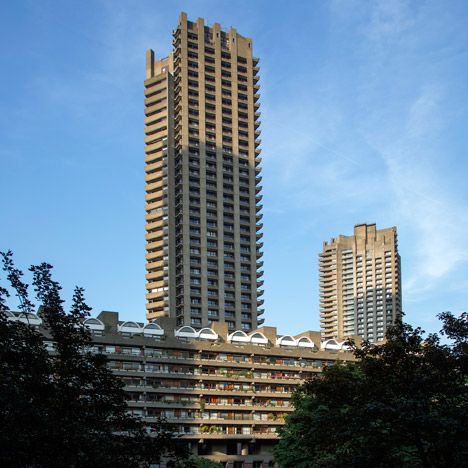Brutalism: described by Queen Elizabeth as "one of the modern wonders of the world", the Barbican Estate in London is one of the largest examples of the Brutalist style and represents a utopian ideal for inner-city living.
The post-war complex was designed in the 1950s by British firm Chamberlin, Powell and Bon – a team of three young architects who had recently established their reputation by winning the the 1951 design competition for the nearby Golden Lane Estate.
With its coarse concrete surfaces, elevated gardens and trio of high-rise towers, the Barbican Estate offered a new vision for how high-density residential neighbourhoods could be integrated with schools, shops and restaurants, as well world-class cultural destinations.
The architects – Peter Chamberlin, Geoffry Powell and Christoph Bon – sought to create a complex that created a clear distinction between private, community and public domains, but that also allowed pedestrians as much priority as cars.
Architect Piers Gough, who cites the Barbican as one of his biggest influences, told Dezeen that the project's "terrific complexity" is what makes it so unique.
"From a civilisation with apparently no word for dimensions of less a foot, came a totally complete, stonkingly powerful, three-dimensional city wrapped around a sumptuous landscape of green squares and lakes," he said.
The site had been left almost entirely demolished by bombing during the second world war, so the architects were tasked with developing an entire city plot from scratch.
Designs were finalised in 1959, construction extended through the 60s and 70s, and the complex was officially opened by the queen in 1982.
The basis for the design came from a vision for a podium, a car-free realm raised up over the city's busy streets to allow visitors and residents to explore the site on foot.
Brick pathways indicate different routes, while landscaped gardens and lakes offer a pleasant outlook for residents.
Flats were distributed between three 43-storey towers – known as Shakespeare, Cromwell and Lauderdale – and a series of 13 seven-storey blocks. Aimed at young professionals, the residences feature simple layouts with compact kitchens and bathrooms.
Balconies branch off bedrooms and studies, as well as living rooms, and give the towers their unique profiles.
Externally, the raw concrete surfaces were bush-hammered to reveal the rough texture of the aggregate.
"The materials are solid, the details – lamps, handrails, gates, gutters – seem to have been adopted from a second world war battleship," said Jonathan Glancey, the former Guardian critic who moved into the Barbican in the late 90s.
"The sheer number of ramps, decks, stairs, handrails and balconies here, plus the overtly nautical detailing, makes the Barbican feel, particularly on rain-soaked, windswept days, like some great concrete ship that has come to berth in the City of London," he said.
With the Corporation of London as a client, the project was intended to create a mixed society of residents, but the change in politics brought in during Margaret Thatcher's term as Britain's prime minister inevitably led to the majority of homes being sold to private owners and landlords.
These days the address is highly sought after, with properties selling for as much as £4 million.
Fenella Beevor moved to the Barbican in 1974 with her late husband. Forty years later, she says it's gradually developed into a settled and welcoming community.
"I've seen all sorts of people come and go, but I love my flat and I wouldn't dream of moving," she told Dezeen.
The Barbican Centre was revisited ahead of its 25th anniversary by British architecture firm Allford Hall Monaghan Morris, with a scheme that rationalised what many felt to be the estate's only failing – orientation.
The £12.6 million project involved introducing new signage elements that would help to guide visitors around the huge site, adding a more legible public realm at the entrance to the arts centre, and improving acoustics.
"The architectural rigour evident across the estate, its mixed-use programme and the sheer scale of the undertaking make the Barbican a very significant work within the evolution of post-war British architecture," said architect and AHMM director Peter Morris.
"We weren't disposed to fundamentally change the building, rather to work with it, recognising and celebrating the building's best qualities while dealing head-on with its deficiencies. A combination of radical surgery and a series of robust insertions complemented the massive interior landscape rather than trying to compete with it, while clarifying and improving access to the multiple venues," he added.

